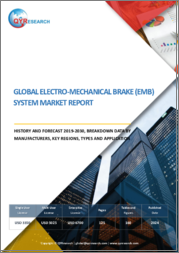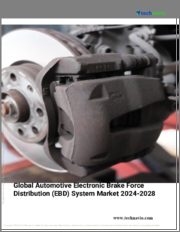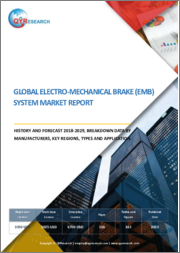
|
시장보고서
상품코드
1747450
세계의 자동차용 전자 브레이크 시스템(EBS) 시장 : 차량 유형별, 컴포넌트 유형별, 기술 유형별, 지역별 - 기회 및 예측(2018-2032년)Global Automotive Electronic Brake System Market Assessment, By Vehicle Type, By Component Type, By Technology Type, By Region, Opportunities and Forecast, 2018-2032F |
||||||
세계 자동차용 전자 브레이크 시스템(EBS) 시장 규모는 자동차 안전에 대한 수요 증가와 기술 발전으로 인해 2025-2032년의 예측 기간 동안 6.65%의 연평균 복합 성장률(CAGR)로 2024년 308억 3,000만 달러에서 2032년 516억 달러로 성장할 것으로 예측됩니다. ABS, BbW(Brake-by-Wire), AEB와 같은 EBS 기술은 제동 효율과 안정성을 향상시켜 최근 자동차의 표준이 되고 있습니다. 전기차와 자율주행차의 등장은 이러한 자동차가 첨단 제동 시스템을 필요로 하기 때문에 시장을 더욱 촉진하고 있습니다. 또한, 전 세계적으로 안전 규제가 강화됨에 따라 제조업체들은 차량 제품에 고급 EBS를 통합하여 컴플라이언스 및 교통 안전성을 향상시켜야 하는 상황에 직면해 있습니다.
예를 들어, 2025년 4월 Nexteer Automotive Corporation은 소프트웨어 정의 섀시 통합을 용이하게 하면서 안전, 편의성, 유지보수성을 향상시키도록 설계된 새로운 전자기계식 브레이크(EMB)를 발표했습니다. Nexteer는 광범위한 섀시 모션 제어 전략의 초기 단계로 EMB를 개발했으며, Nexteer의 역량, 툴 세트, 소프트웨어 제어, 하드웨어 구성 요소의 상당 부분을 첨단 조향 및 브레이크 개발에 활용하고 있습니다. 스티어링과 브레이크 개발 모두에 활용되고 있습니다.
세계의 자동차용 전자식 브레이크 시스템 시장에 대해 조사했으며, 시장 개요와 함께 차량 유형별/부품 유형별/기술 유형별/지역별 동향, 시장 진출 기업 프로파일 등의 정보를 전해드립니다.
목차
제1장 프로젝트의 범위와 정의
제2장 조사 방법
제3장 미국 관세의 영향
제4장 주요 요약
제5장 고객 소리
제6장 세계의 자동차용 전자 브레이크 시스템(EBS) 시장 전망, 2018년-2032년
- 시장 규모 분석과 예측
- 시장 점유율 분석과 예측
- 차량 유형별
- 승용차
- 상용차
- 컴포넌트 유형별
- 센서
- 액추에이터
- 제어 유닛
- 기타
- 기술 유형별
- 브레이크 어시스턴스
- 자동 긴급 제동 장치
- 전자 안정 제어
- 안티락 브레이크 시스템
- 지역별
- 북미
- 유럽
- 아시아태평양
- 남미
- 중동 및 아프리카
- 기업별 시장 점유율 분석(주요 5개사 및 기타-금액별, 2024년)
- 차량 유형별
- 2024년 시장 맵 분석
제7장 북미의 자동차용 전자 브레이크 시스템(EBS) 시장 전망, 2018년-2032년
- 시장 규모 분석과 예측
- 시장 점유율 분석과 예측
- 국가별 시장 평가
- 미국
- 캐나다
- 멕시코
제8장 유럽의 자동차용 전자 브레이크 시스템(EBS) 시장 전망, 2018년-2032년
- 독일
- 프랑스
- 이탈리아
- 영국
- 러시아
- 네덜란드
- 스페인
- 튀르키예
- 폴란드
제9장 아시아태평양의 자동차용 전자 브레이크 시스템(EBS) 시장 전망, 2018년-2032년
- 인도
- 중국
- 일본
- 호주
- 베트남
- 한국
- 인도네시아
- 필리핀
제10장 남미의 자동차용 전자 브레이크 시스템(EBS) 시장 전망, 2018년-2032년
- 브라질
- 아르헨티나
제11장 중동 및 아프리카의 자동차용 전자 브레이크 시스템(EBS) 시장 전망, 2018년-2032년
- 사우디아라비아
- 아랍에미리트(UAE)
- 남아프리카
제12장 Porter의 Five Forces 분석
제13장 PESTLE 분석
제14장 시장 역학
- 시장 성장 촉진요인
- 시장이 해결해야 할 과제
제15장 시장 동향과 발전
제16장 사례 연구
제17장 경쟁 구도
- 시장 리더 주요 5개사의 경쟁 매트릭스
- 참여 기업 주요 5개사의 SWOT 분석
- 시장 주요 기업 10개사의 상황
- ZF Friedrichshafen AG
- Knorr-Bremse Commercial Vehicle Systems GmbH
- Continental AG
- Haldex AB
- HL Mando Corp
- AKEBONO BRAKE INDUSTRY CO., LTD
- Robert Bosch GmbH
- A.B.S. All Brake Systems B.V.
- DENSO Corporation
- BRANO Group
제18장 전략적 제안
제19장 회사 소개 및 면책조항
LSH 25.06.20Global automotive electronic brake System (EBS) market is projected to witness a CAGR of 6.65% during the forecast period 2025-2032, growing from USD 30.83 billion in 2024 to USD 51.60 billion in 2032F, owing to increasing demand for vehicle safety and technological advancements. EBS technologies, such as ABS, Brake-by-Wire (BbW) and AEB, are becoming standard in modern vehicles, enhancing brake efficiency and stability. The rise of electric and autonomous vehicles further propels the market, as these vehicles require advanced braking systems. Additionally, stringent safety regulations worldwide are compelling manufacturers to integrate sophisticated EBS into their vehicle offerings, ensuring compliance and improved road safety.
For instance, in April 2025, Nexteer Automotive Corporation introduced a new Electro-Mechanical Brake (EMB), a Brake-by-Wire system solution designed to improve safety, comfort, and serviceability while facilitating software-defined chassis integration. Nexteer developed the EMB as an initial phase in a more extensive chassis motion control strategy. A considerable number of Nexteer's competencies, toolsets, software controls, and hardware components are utilized across both its advanced steering and braking development.
Regulatory Mandates and Advancements to Shape the Automotive Electronic Brake System Market
Governments worldwide are enforcing stringent safety regulations to reduce road accidents and fatalities. These mandates require the integration of advanced braking systems such as ABS and ESC in vehicles. Such regulations not only ensure passenger safety but also drive the demand for EBS technologies. Manufacturers are compelled to adopt these systems to comply with legal standards, leading to widespread implementation across various vehicle segments and contributing significantly to market growth.
The automotive industry is also witnessing rapid technological evolution, with a focus on enhancing vehicle safety and performance. Innovations in sensor technologies, artificial intelligence, and machine learning are being integrated into braking systems, resulting in more responsive and efficient EBS. These advancements not only improve braking performance but also support the development of autonomous driving features, making EBS a critical component in modern vehicles and fueling market expansion.
For instance, in December 2023, Knorr-Bremse Commercial Vehicle Systems GmbH introduced the latest generation of iTEBS X electronic trailer braking system. This system refines the range of functions on offer and simplifies the connectivity of the individual braking system components, including the parking and maneuvering valve and air suspension.
Rise in Electric and Hybrid Vehicles to Fuel Automotive Electronic Brake System Market Demand
The global shift towards electric and hybrid vehicles is influencing the EBS market positively. These vehicles often incorporate regenerative braking systems, which recover energy during braking, enhancing efficiency. The integration of electronic braking systems is essential in managing the unique braking requirements of electric drivetrains. As the adoption of electric and hybrid vehicles increases, so does the demand for advanced EBS, driving market growth. These braking solutions come with additional integrated technology, making them dependable for future-ready EVs.
For instance, in September 2024, Accelera (Cummins Inc.) unveiled its latest integrated brake chopper resistor (iBCR) during the IAA Transportation event held in Hannover, Germany. This cutting-edge iBCR features strong cybersecurity measures, improved performance, and greater reliability, with the goal of enhancing the safety and efficiency of commercial electric vehicles.
Modern consumers prioritize vehicle safety features when making purchasing decisions. The awareness of safety technologies such as automatic emergency braking and stability control has grown, leading to increased demand for vehicles equipped with advanced EBS. Manufacturers respond to rising demand by incorporating sophisticated braking systems into their models, not only to attract conscious buyers but also to differentiate their offerings in a competitive market, thereby boosting the global market.
Passenger Cars Lead in the Global Automotive Electronic Brake System Market
Based on vehicle type, the passenger car segment dominates the automotive electronic brake system market due to several factors. Firstly, the sheer volume of passenger vehicles produced and sold globally surpasses that of commercial vehicles, leading to higher demand for braking systems. Secondly, consumer expectations for safety and comfort in personal vehicles drive manufacturers to integrate advanced EBS technologies such as ABS, ESC, and AEB. Regulatory mandates requiring such systems in new passenger cars further bolster this trend.
Additionally, the rise of electric and hybrid passenger vehicles necessitates specialized braking solutions, including regenerative braking systems, contributing to market growth. The increasing adoption of autonomous driving features in passenger cars also emphasizes the need for dependable and sophisticated EBS, ensuring vehicle control and passenger safety. Collectively, these factors establish the passenger car segment as the leading contributor to the automotive EBS market among private vehicle owners, also strengthening aftermarket demand in this segment. Companies introduce new braking technology, especially for the passenger vehicle segment.
For instance, in May 2023, Continental AG introduced a new electronic brake system to support electronic stability control at Changan. The electronic brake system, which is both compact and efficient, addresses the requirements of electrification and automated driving, incorporating cybersecurity features and over-the-air capabilities. Additional production sites in Europe, Japan, and India are planned to be established. This system is designed for passenger vehicles produced by manufacturers across the globe.
Asia-Pacific Leads in the Global Automotive Electronic Brake System Market
Asia-Pacific leads the automotive electronic brake system market, driven by rapid industrialization, urbanization, and a burgeoning middle class demanding safer vehicles. Countries such as China, Japan, and India are major automotive manufacturing hubs, producing a significant share of global vehicles. Government initiatives promoting vehicle safety, such as mandatory ABS and ESC systems, have accelerated EBS adoption. The region's focus on electric and hybrid vehicles, particularly in China, necessitates advanced braking systems, including regenerative braking. Furthermore, local manufacturers are investing in research and development to innovate cost-effective electronic braking solutions, custom-made for regional demands.
Collaborations between domestic and international firms enhance technology transfer and market penetration. The combination of supportive policies, manufacturing capabilities, and consumer awareness positions Asia-Pacific as a dominant force in the global automotive electronic brake system market, with continued growth anticipated in the coming years.
Impact of the U.S. Tariff on the Global Automotive Electronic Brake System Market
The imposition of 25% tariffs on imports from Mexico and Canada by the United States has disrupted the automotive supply chain, significantly affecting the EBS market. Manufacturers reliant on cross-border trade face increased production costs, leading to higher vehicle prices. This cost escalation may result in reduced demand for new vehicles, subsequently impacting on the adoption of advanced braking systems. Additionally, the tariffs strain relationships within the North American automotive industry, potentially leading to job losses and economic instability, further challenging the growth of the EBS market in the region.
Key Players Landscape and Outlook
Key players in the automotive electronic brake system market are focusing on innovation and strategic partnerships to maintain competitiveness. Competitors invest heavily in research and development to enhance the performance and reliability of braking systems, ensuring compliance with evolving safety standards. Collaborations with technology firms facilitate the integration of advanced features such as AI-driven diagnostics and predictive maintenance. Furthermore, these companies are expanding their global footprint through joint ventures and localized manufacturing, reducing dependency on specific markets and mitigating risks associated with trade policies. By aligning product development with emerging trends such as electric mobility and autonomous driving, they position themselves to meet future market demands effectively.
For instance, in November 2023, ZF Friedrichshafen AG introduced a new purely electro-mechanical brake-by-wire system at its Next Generation Mobility Day in Shanghai. This innovative, fluid-free braking technology, developed in China, the USA, and Germany, promises shorter braking distances, improved energy recovery, and reduced maintenance for software-defined vehicles.
Table of Contents
1. Project Scope and Definitions
2. Research Methodology
3. Impact of U.S. Tariffs
4. Executive Summary
5. Voice of Customers
- 5.1. Respondent Demographics
- 5.2. Brand Awareness
- 5.3. Factors Considered in Purchase Decisions
- 5.4. Unmet Needs
6. Global Automotive Electronic Brake System Market Outlook, 2018-2032F
- 6.1. Market Size Analysis & Forecast
- 6.1.1. By Value
- 6.2. Market Share Analysis & Forecast
- 6.2.1. By Vehicle Type
- 6.2.1.1. Passenger Cars
- 6.2.1.2. Commercial Vehicles
- 6.2.2. By Component Type
- 6.2.2.1. Sensors
- 6.2.2.2. Actuators
- 6.2.2.3. Control Units
- 6.2.2.4. Others
- 6.2.3. By Technology Type
- 6.2.3.1. Brake Assistance
- 6.2.3.2. Autonomous Emergency Braking
- 6.2.3.3. Electronic Stability Control
- 6.2.3.4. Anti-Lock Braking System
- 6.2.4. By Region
- 6.2.4.1. North America
- 6.2.4.2. Europe
- 6.2.4.3. Asia-Pacific
- 6.2.4.4. South America
- 6.2.4.5. Middle East and Africa
- 6.2.5. By Company Market Share Analysis (Top 5 Companies and Others - By Value, 2024)
- 6.2.1. By Vehicle Type
- 6.3. Market Map Analysis, 2024
- 6.3.1. By Vehicle Type
- 6.3.2. By Component Type
- 6.3.3. By Technology Type
- 6.3.4. By Region
7. North America Automotive Electronic Brake System Market Outlook, 2018-2032F
- 7.1. Market Size Analysis & Forecast
- 7.1.1. By Value
- 7.2. Market Share Analysis & Forecast
- 7.2.1. By Vehicle Type
- 7.2.1.1. Passenger Cars
- 7.2.1.2. Commercial Vehicles
- 7.2.2. By Component Type
- 7.2.2.1. Sensors
- 7.2.2.2. Actuators
- 7.2.2.3. Control Units
- 7.2.2.4. Others
- 7.2.3. By Technology Type
- 7.2.3.1. Brake Assistance
- 7.2.3.2. Autonomous Emergency Braking
- 7.2.3.3. Electronic Stability Control
- 7.2.3.4. Anti-Lock Braking System
- 7.2.4. By Country Share
- 7.2.4.1. United States
- 7.2.4.2. Canada
- 7.2.4.3. Mexico
- 7.2.1. By Vehicle Type
- 7.3. Country Market Assessment
- 7.3.1. United States Automotive Electronic Brake System Market Outlook, 2018-2032F*
- 7.3.1.1. Market Size Analysis & Forecast
- 7.3.1.1.1. By Value
- 7.3.1.2. Market Share Analysis & Forecast
- 7.3.1.2.1. By Vehicle Type
- 7.3.1.2.1.1. Passenger Cars
- 7.3.1.2.1.2. Commercial Vehicles
- 7.3.1.2.2. By Component Type
- 7.3.1.2.2.1. Sensors
- 7.3.1.2.2.2. Actuators
- 7.3.1.2.2.3. Control Units
- 7.3.1.2.2.4. Others
- 7.3.1.2.3. By Technology Type
- 7.3.1.2.3.1. Brake Assistance
- 7.3.1.2.3.2. Autonomous Emergency Braking
- 7.3.1.2.3.3. Electronic Stability Control
- 7.3.1.2.3.4. Anti-Lock Braking System
- 7.3.1.2.1. By Vehicle Type
- 7.3.1.1. Market Size Analysis & Forecast
- 7.3.2. Canada
- 7.3.3. Mexico
- 7.3.1. United States Automotive Electronic Brake System Market Outlook, 2018-2032F*
All segments will be provided for all regions and countries covered
8. Europe Automotive Electronic Brake System Market Outlook, 2018-2032F
- 8.1. Germany
- 8.2. France
- 8.3. Italy
- 8.4. United Kingdom
- 8.5. Russia
- 8.6. Netherlands
- 8.7. Spain
- 8.8. Turkey
- 8.9. Poland
9. Asia-Pacific Automotive Electronic Brake System Market Outlook, 2018-2032F
- 9.1. India
- 9.2. China
- 9.3. Japan
- 9.4. Australia
- 9.5. Vietnam
- 9.6. South Korea
- 9.7. Indonesia
- 9.8. Philippines
10. South America Automotive Electronic Brake System Market Outlook, 2018-2032F
- 10.1. Brazil
- 10.2. Argentina
11. Middle East and Africa Automotive Electronic Brake System Market Outlook, 2018-2032F
- 11.1. Saudi Arabia
- 11.2. UAE
- 11.3. South Africa
12. Porter's Five Forces Analysis
13. PESTLE Analysis
14. Market Dynamics
- 14.1. Market Drivers
- 14.2. Market Challenges
15. Market Trends and Developments
16. Case Studies
17. Competitive Landscape
- 17.1. Competition Matrix of Top 5 Market Leaders
- 17.2. SWOT Analysis for Top 5 Players
- 17.3. Key Players Landscape for Top 10 Market Players
- 17.3.1. ZF Friedrichshafen AG
- 17.3.1.1. Company Details
- 17.3.1.2. Key Management Personnel
- 17.3.1.3. Key Products Offered
- 17.3.1.4. Key Financials (As Reported)
- 17.3.1.5. Key Market Focus and Geographical Presence
- 17.3.1.6. Recent Developments/Collaborations/Partnerships/Mergers and Acquisitions
- 17.3.2. Knorr-Bremse Commercial Vehicle Systems GmbH
- 17.3.3. Continental AG
- 17.3.4. Haldex AB
- 17.3.5. HL Mando Corp
- 17.3.6. AKEBONO BRAKE INDUSTRY CO., LTD
- 17.3.7. Robert Bosch GmbH
- 17.3.8. A.B.S. All Brake Systems B.V.
- 17.3.9. DENSO Corporation
- 17.3.10. BRANO Group
- 17.3.1. ZF Friedrichshafen AG
Companies mentioned above DO NOT hold any order as per market share and can be changed as per information available during research work.

















